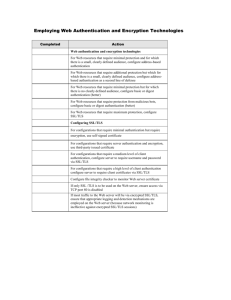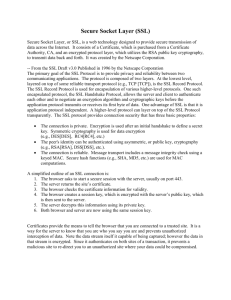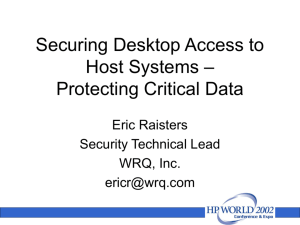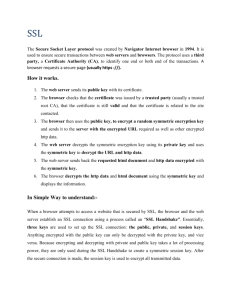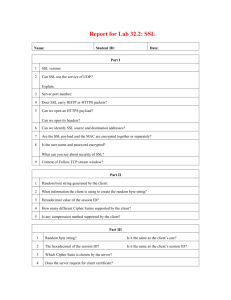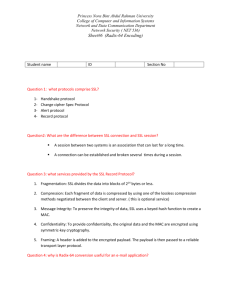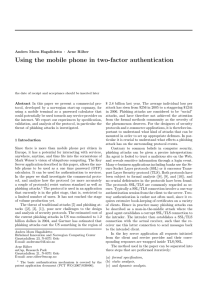Security in Online Banking
advertisement
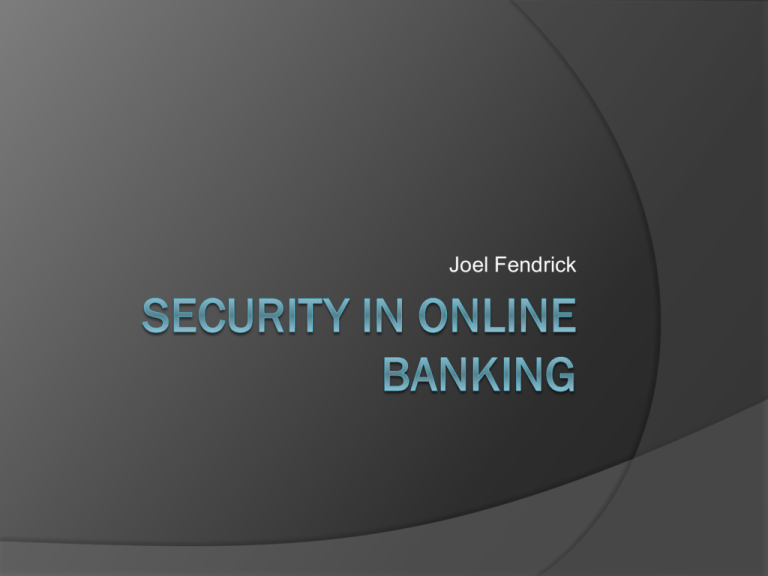
Joel Fendrick
Overview
Encryption Methods
AES (Advanced Encryption Standard)
SSL (Secure Socket Layer)
TLS (Transport Layer Security)
TLS Advantage Over SSL
Security Example
Attacks
Countermeasure
Encryption Methods
Asymmetric
Symmetric
Hashing
Asymmetric
Each user has two keys
Private
Public
Public key stored in public database
Messages encrypted with public key can
only be decrypted with private key.
Encrypted with private -> decrypted with
public
Symmetric
No private/public
Only means of decryption is if you have
the right key
Security issue in exchanging the key
Hashing
Unique fixed length string of characters
from selected text
One way process
Cannot recreate document from hash
If anything changes in text, hash would
change
Can be used to determine integrity of file
Suppose hash of a document was:
9c5292056062f70a2f14330cf4d30c7f
If anything at all changes in document a new hash
is formed
91857f37a636882c78de9961e791c81a
Making it easy to tell if the message has been
altered in any way
AES (Advanced Encryption
Standard)
Cryptographic algorithm used to protect
electronic data
Block cipher that can encrypt and
decrypt information
Capable of using keys of 128, 192, and
256 bits
Encrypts data into blocks of 128 bits
Pseudo code
http://www.garykessler.net/library/crypto.html#fig17
in[] and out[]
16-byte arrays with the plaintext and cipher text,
respectively. (According to the specification, both
of these arrays are actually 4*Nb bytes in length
but Nb=4 in AES.)
w[]
array containing the key material and is 4*(Nr+1)
words in length. (Again, according to the
specification, the multiplier is actually Nb.)
state[]
a 2-dimensional array containing bytes in 4 rows
and 4 columns. (According to the specification,
this arrays is 4 rows by Nb columns.)
SubBytes
takes the value of a word within a State and
substitutes it with another value by a predefined Sbox
ShiftRows
circularly shifts each row in the State by some
number of predefined bytes
MixColumns
takes the value of a 4-word column within the
State and changes the four values using a
predefined mathematical function
AddRoundKey
XORs a key that is the same length as the block,
using an Expanded Key derived from the original
Cipher Key
Walkthrough
This walkthrough is of Rijndael encryption
Rijndael allows for both key and block sizes to
be chosen independently from the set of { 128,
160, 192, 224, 256 } bits. (And the key size
does not in fact have to match the block size).
However, the block size must always be 128 bits
in AES, and the key size may be either 128,
192, or 256 bits.
http://www.formaestudio.com/rijndaelinspec
tor/
AES Flaw
2009 weakness identified
Interesting in mathematical P.O.V.
Not really relevant in application
Finding the key of AES is four times
easier than previously believed
Steps to find = 8 followed by 37 zeroes
1 trillion machines each test 1 billion
keys per second
Would take more than 2 billion years to
recover AES-128 key
Andrey Bogdanov (K.U.Leuven),
Dmitry Khovratovich (Microsoft
Research),
Christian Rechberger (ENS Paris)
SSL (Secure Socket Layer)
3 basic properties
Connection is private
Peer’s identity can be authenticated using
asymmetric cryptography
Connection is reliable
○ message check using keyed Message
Authentication Code (MAC)
Two layers: can include length description
and content
Lowest Layer = SSL Record Protocol
Second Layer = Handshake Protocol
TLS (Transport Layer Security)
Two layers
TLS Record Protocol
TLS Handshake Protocol
Encapsulates higher level protocols
TLS Record Protocol
Two basic properties
The connection is private
○ Symmetric Data encryption
The connection is reliable
○ Keyed MAC included in each message
TLS Handshake Protocol
Three basic properties
Peer’s identity can be authenticated using
asymmetric or public key cryptography
The negotiation of a shared secret is secure
The negotiation is reliable
Advantage over SSL
Application protocol independent
Higher level protocols can layer on top of it
transparently
○ Decisions on how to initiate TLS handshaking
and how to interpret authentication certificates
are left up to the designers of the higher level
protocols
Security Example
Either SSL or TLS protocol
We’ll focus on SSL since it is the basis for
TLS
Browser sends message via SSL to bank
server
Bank responds by sending a certificate
Includes banks public key
Browser authenticates certificate and
generate random session key
Uses this key to encrypt the data
Bank’s server receives session key and
decrypts
Key was sent encrypted by bank’s public key
Bank uses private key to decrypt
Session key that now both bank and client
know is used for rest of communication
Banks Didn’t Use SSL?
As of 2006 a number of big banks were not requiring
the use of SSL authentication
Bank of America
Wachovia
US Bank
Chase
American Express
Etc.
SSL login form listed as
optional
Outside the US at this time
HSBC was the only known
bank not to use SSL
authentication
○ British multinational banking
and financial services
company
Attacks
Man-in-the-middle
Man-in-the-browser
Man-in-the-middle
Someone intercepts the communication
between two systems
Specific MITM Attack
Victim visits site that uses TLS 1.0 and
receives a cookie, this cookie injects the
client-side BEAST (Browser Exploit
Against SSL/TLS)
Attacker can now use a network sniffer
to look for active TLS connections
Grabs and decrypts the HTTPS cookie
○ Allows attacker to hijack victim’s session with
that site.
Solution
Difficult
Attacks confidentiality VS authenticity like
most attacks
Requires major change in the protocol itself
There are some fixes, but they cause
compatibility issue with some existing SSL
applications
Man-in-the-browser
Malware already infecting user computer
Kicks in after user has logged onto site
Hijack money and siphon it into criminal
accounts
Solution
Use a trusted browser
Can be stored on a flash drive
Since stored in own secure environment it is
not susceptible to malware in the same way
as a traditional browser
Countermeasure
Historically piecemeal approach
Generally recommends several defenses
that support each other
Often creates gaps within the layer
architecture leaving some elements exposed
to threats
Some banks implement a secure USB token
“provides secure online banking session even if
computer is riddled with malware”
Read-only portable USB device
○ When plugged in encrypts the customers
keystrokes
○ Launches virtualized OS
○ Launches secure browser
○ Launches a secure network between client and
bank server
This is an attempt to create a virtual machine
that is walled off from the rest of the PC
Protection from clients system
Makes sense that banks would want to
protect their customers, as they are often the
weakest link and biggest threat vector
Conclusion
Be careful and aware
Pay attention and confirm site is
legitimate
Security is evolving , but so are the
attacks
References
[1] HIPAA Collaborative of Wisconsin. (2010). The Basics of Encryption. Retrieved on March 22, 2012, from
http://www.hipaacow.org/docs/encryption%20whitepaper%207.7.10.doc
[2] NIST. (2001). Retrieved on March 22, 2012, from FIPS Publications website: http://csrc.nist.gov/publications/fips/fips197/fips-197.pdf
[3] Katholieke Universiteit Leuven (2011, August 17). First flaws in the Advanced Encryption Standard used for internet banking
identified. ScienceDaily. Retrieved on March 22, 2012, from http://www.sciencedaily.com/releases/2011/08/110817075424.htm
[4] Dierks, T., & Rescorla, E. (2008, August). The Transport Layer Security (TLS) Protocol Version 1.2. Retrieved on March 22, 2012, from
http://tools.ietf.org/html/rfc5246
[5] Freier, A., & Karlton, P. (2011, August). The Secure Sockets Layer (SSL) Protocol Version 3.0. Retrieved on March 22, 2012, from
http://tools.ietf.org/html/rfc6101
[6] Onyszko, T. (2002, July 19). WindowsSecurity.com. Retrieved on March 23, 2012, from
http://www.windowsecurity.com/articles/secure_socket_layer.html
[7] Online banking security and technical frequently asked questions. (2012). Retrieved on March 23, 2012, from
http://www.bankofamerica.com/onlinebanking/index.cfm?adlink=&context=en&locale=&statecheck=WI&template=faq_security&cm_mmc=&cm_sp=
[8] Ou, G. (2006, April 27). Many banks failing to use ssl authentication. Retrieved on March 23, 2012, from
http://www.zdnet.com/blog/ou/many-banks-failing-to-use-ssl-authentication/201
[9] OWASP. (2009, April 23). The open web application security project. Retrieved on March 23, 2012, from
https://www.owasp.org/index.php/Man-in-the-middle_attack
[10] Fisher, D. (2011, September 19). threatpost. Retrieved on March 23, 2012, from http://threatpost.com/en_us/blogs/new-attack-breaksconfidentiality-model-ssl-allows-theft-encrypted-cookies-091911
[11] Bethlehem, D. (2012, February 12). Strong authentication by itself is not enough to prevent man-in-the-browser attacks. Retrieved on March 24,
2012, from http://data-protection.safenet-inc.com/2012/02/strong-
[12] Ramirez, D. (2007). Case study: Itu-t recommendation x.805 applied to an enterprise environment— banking. Bell Labs Technical Journal, 12(3),
55-64.
[13] (2011). Securing the weakest link. Bank Technology News,24(6), 1 & 35.

